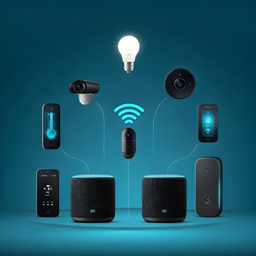Efficient MQTT-CoAP Bridge for Cloud and 6LoWPAN IoT
Building Scalable PIC-Based IoT Architectures for Expansion
Designing a scalable architecture for Internet of Things (IoT) applications with PIC microcontrollers requires a careful balance of hardware, firmware, and communication strategies. In this tutorial, we will explore key concepts and techniques to create a robust IoT system that can handle the increasing demands of connected devices, data processing, and security. By focusing on modular design and best practices, you will be well-equipped to develop larger, more complex IoT solutions centered around PIC microcontrollers Introduction to PIC: Exploring the Basics of Microcontroller ArchitectureExplore the core principles of PIC microcontroller architecture, including Harvard design, RISC processing, and efficient memory organization..
Introduction to PIC: Exploring the Basics of Microcontroller ArchitectureExplore the core principles of PIC microcontroller architecture, including Harvard design, RISC processing, and efficient memory organization..
Understanding the Foundation of IoT Architecture🔗
IoT solutions often involve multiple layers, each serving distinct functions in data acquisition, communication, and processing. A simplified overview of these layers includes:
1. Device/Edge Layer – PIC microcontrollers Introduction to PIC: Exploring the Basics of Microcontroller ArchitectureExplore the core principles of PIC microcontroller architecture, including Harvard design, RISC processing, and efficient memory organization. and peripheral sensors or actuators.
Introduction to PIC: Exploring the Basics of Microcontroller ArchitectureExplore the core principles of PIC microcontroller architecture, including Harvard design, RISC processing, and efficient memory organization. and peripheral sensors or actuators.
2. Gateway/Connectivity Layer – Modules or platforms enabling wired or wireless data transfer (Ethernet, Wi-Fi, Bluetooth, etc.).
3. Cloud/Server Layer – Backend services storing, analyzing, and visualizing data.
Scalability emerges from designing each layer to allow easy expansion and seamless integration with existing systems or additional microcontrollers.
Hardware Considerations for Scalable PIC-Based IoT🔗
Choosing the right PIC microcontroller Introduction to PIC: Exploring the Basics of Microcontroller ArchitectureExplore the core principles of PIC microcontroller architecture, including Harvard design, RISC processing, and efficient memory organization. and complementary hardware components is crucial. Key considerations include:
Introduction to PIC: Exploring the Basics of Microcontroller ArchitectureExplore the core principles of PIC microcontroller architecture, including Harvard design, RISC processing, and efficient memory organization. and complementary hardware components is crucial. Key considerations include:
| Hardware Aspect | Considerations |
|---|---|
| Microcontroller Selection | Look for MCUs with adequate processing and memory resources to handle future firmware upgrades. |
| Connectivity Modules | Decide on communication (e.g., Ethernet, Wi-Fi, LoRa, or cellular) based on distance, bandwidth, and power constraints. |
| Expandability | Use expansion connectors or modular boards that can adapt to new sensor inputs or emerging communication standards. |
| Security Hardware | For sensitive applications, consider MCUs or modules with built-in crypto engines or dedicated secure elements. |
By anticipating future needs, you can avoid costly redesigns and ensure that your IoT ecosystem can scale effectively.
Communication Protocols for Scalable IoT🔗
MQTT for Lightweight Publish/Subscribe
MQTT (Message Queuing Telemetry Transport) is a popular protocol for IoT because it follows a lightweight publish/subscribe model:
- Devices (PIC microcontrollers
 Introduction to PIC: Exploring the Basics of Microcontroller ArchitectureExplore the core principles of PIC microcontroller architecture, including Harvard design, RISC processing, and efficient memory organization.) connect to a central broker.
Introduction to PIC: Exploring the Basics of Microcontroller ArchitectureExplore the core principles of PIC microcontroller architecture, including Harvard design, RISC processing, and efficient memory organization.) connect to a central broker. - Data is published to a topic, and any device subscribed to that topic receives the message.
- This architecture decouples data sources (publishers) from consumers (subscribers), allowing easy expansion without reworking all nodes.
HTTP/HTTPS for Compatibility
For applications that require web-based integration, HTTP/HTTPS remains a common choice:
- Widely supported by cloud platforms and web services.
- Often used for RESTful APIs when sending sensor
 Analog-to-Digital Conversion: Connecting Sensors to PICExplore our step-by-step PIC microcontroller ADC tutorial, including sensor interfacing techniques and C code examples to achieve accurate conversions. data or receiving control commands.
Analog-to-Digital Conversion: Connecting Sensors to PICExplore our step-by-step PIC microcontroller ADC tutorial, including sensor interfacing techniques and C code examples to achieve accurate conversions. data or receiving control commands. - Security can be enhanced using TLS (Transport Layer Security), which is critical for ensuring data integrity.
Custom Protocols over TCP/UDP
In specialized, low-latency, or high-throughput scenarios, building a custom protocol might be favorable:
- Custom headers or simplified packet structures.
- Direct integration with real-time
 Implementing Interrupt-Driven Systems for Real-Time ApplicationsLearn to configure and optimize PIC microcontroller interrupts for real-time performance. Enhance responsiveness and efficiency using best practices. operating systems.
Implementing Interrupt-Driven Systems for Real-Time ApplicationsLearn to configure and optimize PIC microcontroller interrupts for real-time performance. Enhance responsiveness and efficiency using best practices. operating systems. - Reduced overhead for mission-critical data transfer.
Security and Reliability at Scale🔗
When scaling an IoT network, security and reliability must be at the forefront:
1. Data Encryption:
Use TLS/SSL for communication with cloud services. PIC devices can handle cryptographic tasks Integrating Real-Time Operating Systems (RTOS) on PIC32Learn how to effectively integrate an RTOS into your PIC32 project to manage tasks, optimize timing, and maintain real-time, scalable performance. if you optimize code and enable hardware-based crypto accelerators.
Integrating Real-Time Operating Systems (RTOS) on PIC32Learn how to effectively integrate an RTOS into your PIC32 project to manage tasks, optimize timing, and maintain real-time, scalable performance. if you optimize code and enable hardware-based crypto accelerators.
Implement a chain-of-trust boot process and consider secure firmware update Creating a Custom Bootloader and Firmware Update SystemExplore a guide to designing a custom bootloader for PIC microcontrollers. Learn to manage firmware updates and memory partitioning for reliable booting. mechanisms. Authenticating firmware protects against malicious code and ensures that only approved updates are installed.
Creating a Custom Bootloader and Firmware Update SystemExplore a guide to designing a custom bootloader for PIC microcontrollers. Learn to manage firmware updates and memory partitioning for reliable booting. mechanisms. Authenticating firmware protects against malicious code and ensures that only approved updates are installed.
3. Redundancy and Fault Tolerance:
Design the system so that loss of any single device or network link does not cripple the entire IoT deployment. Incorporate watchdog timers Generating Audio with PIC Timers and PWMExplore how to configure PIC timers and PWM for audio signal generation, including hardware setup, duty cycle adjustments and simple tone creation. and fallback communication methods where appropriate.
Generating Audio with PIC Timers and PWMExplore how to configure PIC timers and PWM for audio signal generation, including hardware setup, duty cycle adjustments and simple tone creation. and fallback communication methods where appropriate.
Scaling Through Modularity and Abstraction🔗
A layered and modular codebase is crucial for handling more devices and features without sacrificing maintainability:
- Abstraction Layers: Develop clean interfaces for hardware drivers, networking stacks, and application logic.
- Configuration Management: Use defined configuration structures or files to adapt features (e.g., sensor
 Analog-to-Digital Conversion: Connecting Sensors to PICExplore our step-by-step PIC microcontroller ADC tutorial, including sensor interfacing techniques and C code examples to achieve accurate conversions. arrays, communication parameters) without rewriting code.
Analog-to-Digital Conversion: Connecting Sensors to PICExplore our step-by-step PIC microcontroller ADC tutorial, including sensor interfacing techniques and C code examples to achieve accurate conversions. arrays, communication parameters) without rewriting code. - Reusable Libraries: Break your code into reusable libraries that separate the business logic from hardware-specific implementations.
This approach streamlines further expansion because new endpoints or additional features can be integrated with minimal rewrites.
Designing a Future-Proof Data Flow🔗
A typical data flow in a scalable IoT deployment includes:
Data Acquisition (PIC + Sensors) --> Communication Module --> Cloud or Local Server --> Data Storage and Analytics
Highlights for future-proofing include:
- Buffering and Caching: Prevent data loss during network downtime by storing sensor
 Analog-to-Digital Conversion: Connecting Sensors to PICExplore our step-by-step PIC microcontroller ADC tutorial, including sensor interfacing techniques and C code examples to achieve accurate conversions. data in non-volatile memory or dedicated buffers.
Analog-to-Digital Conversion: Connecting Sensors to PICExplore our step-by-step PIC microcontroller ADC tutorial, including sensor interfacing techniques and C code examples to achieve accurate conversions. data in non-volatile memory or dedicated buffers. - Adaptive Transmission Rates: Allow dynamic adjustments to sampling and transmitting intervals to manage network congestion and conserve power.
- Edge Processing: Perform minimal data processing on the PIC to reduce bandwidth usage and offload the cloud from trivial computations.
Practical Steps to Build a Scalable IoT Project🔗
Below is a general roadmap aligning with best practices Automated Testing and Validation ApproachesDiscover how automated testing boosts reliability in complex PIC firmware. Learn unit, HIL, and simulation techniques for seamless validation.:
Automated Testing and Validation ApproachesDiscover how automated testing boosts reliability in complex PIC firmware. Learn unit, HIL, and simulation techniques for seamless validation.:
1. Start Simple: Initialize a basic connection (e.g., Wi-Fi module + PIC) to publish sensor Analog-to-Digital Conversion: Connecting Sensors to PICExplore our step-by-step PIC microcontroller ADC tutorial, including sensor interfacing techniques and C code examples to achieve accurate conversions. data to a local or cloud broker.
Analog-to-Digital Conversion: Connecting Sensors to PICExplore our step-by-step PIC microcontroller ADC tutorial, including sensor interfacing techniques and C code examples to achieve accurate conversions. data to a local or cloud broker.
2. Implement Security Early: Integrate encryption and authentication methods from the outset.
3. Add Devices Gradually: Introduce additional sensors Analog-to-Digital Conversion: Connecting Sensors to PICExplore our step-by-step PIC microcontroller ADC tutorial, including sensor interfacing techniques and C code examples to achieve accurate conversions., actuators, or microcontrollers, verifying each step’s stability and performance.
Analog-to-Digital Conversion: Connecting Sensors to PICExplore our step-by-step PIC microcontroller ADC tutorial, including sensor interfacing techniques and C code examples to achieve accurate conversions., actuators, or microcontrollers, verifying each step’s stability and performance.
4. Refine Data Handling: Streamline data packets, optimize intervals, or use edge processing to handle growth in device count.
5. Automate Deployments: Use version control, automated test suites, and continuous integration Automated Testing and Validation ApproachesDiscover how automated testing boosts reliability in complex PIC firmware. Learn unit, HIL, and simulation techniques for seamless validation. to reliably deploy updates as the system grows.
Automated Testing and Validation ApproachesDiscover how automated testing boosts reliability in complex PIC firmware. Learn unit, HIL, and simulation techniques for seamless validation. to reliably deploy updates as the system grows.
Final Thoughts🔗
Building a scalable IoT architecture around PIC microcontrollers Introduction to PIC: Exploring the Basics of Microcontroller ArchitectureExplore the core principles of PIC microcontroller architecture, including Harvard design, RISC processing, and efficient memory organization. involves more than just choosing the right MCU. It requires a holistic strategy that covers expandability, communication protocols, data security, and robust software design principles. By carefully planning each layer of your IoT system and anticipating future needs, you create a foundation for growth-capable of supporting a few nodes today and hundreds or thousands tomorrow.
Introduction to PIC: Exploring the Basics of Microcontroller ArchitectureExplore the core principles of PIC microcontroller architecture, including Harvard design, RISC processing, and efficient memory organization. involves more than just choosing the right MCU. It requires a holistic strategy that covers expandability, communication protocols, data security, and robust software design principles. By carefully planning each layer of your IoT system and anticipating future needs, you create a foundation for growth-capable of supporting a few nodes today and hundreds or thousands tomorrow.
With these insights, you are better prepared to design, implement, and maintain PIC-based IoT solutions that can adapt to evolving demands in both scale and complexity.
Author: Marcelo V. Souza - Engenheiro de Sistemas e Entusiasta em IoT e Desenvolvimento de Software, com foco em inovação tecnológica.
References🔗
- Microchip: www.microchip.com
- Microchip Developer Help: microchipdeveloper.com/
 7 months ago
7 months ago
 7 months ago
7 months ago
 8 months ago
8 months ago
 8 months ago
8 months ago
 7 months ago
7 months ago
 7 months ago
7 months ago
 7 months ago
7 months ago
 7 months ago
7 months ago
 7 months ago
7 months ago
 7 months ago
7 months ago
 5 months ago
5 months ago
 5 months ago
5 months ago
 8 months ago
8 months ago
 8 months ago
8 months ago
 8 months ago
8 months ago
 8 months ago
8 months ago
 8 months ago
8 months ago
 8 months ago
8 months ago
 8 months ago
8 months ago
 7 months ago
7 months ago
 7 months ago
7 months ago
 7 months ago
7 months ago
 7 months ago
7 months ago
 7 months ago
7 months ago
 7 months ago
7 months ago
 7 months ago
7 months ago
 7 months ago
7 months ago
 7 months ago
7 months ago
 7 months ago
7 months ago